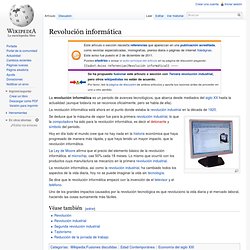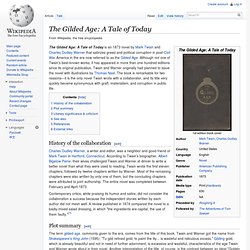

12 Education Tech Trends to Watch in 2012. Revolución informática. La revolución informática es un periodo de avances tecnológicos, que abarca desde mediados del siglo XX hasta la actualidad (aunque todavía no se reconoce oficialmente, pero se habla de ella).

La revolución informática está ahora en el punto donde estaba la revolución industrial en la década de 1820. Se deduce que la máquina de vapor fue para la primera revolución industrial, lo que la computadora ha sido para la revolución informática, es decir el detonante y símbolo del periodo. Hoy en día todo el mundo cree que no hay nada en la historia económica que haya progresado de manera más rápida, y que haya tenido un mayor impacto, que la revolución informática. Tercera revolución industrial. La tercera revolución industrial, tercera revolución científico-técnica o revolución de la inteligencia (RCT) es un concepto y una visión esbozada por Jeremy Rifkin y avalada por el Parlamento Europeo, en una declaración formal aprobada en junio de 2006.[1] A lo largo de la historia, las transformaciones económicas ocurren cuando convergen las nuevas tecnologías de la comunicación con los nuevos sistemas de energía.

Las nuevas formas de comunicación se convierten en el medio de organización y gestión que las civilizaciones más complejas han hecho posible mediante las nuevas fuentes de energía. 1069646562.LGL.2D.4096x4096.png (PNG Image, 4096x4096 pixels) - Scaled (14%) Construccionismo. Ideas centrales del construccionismo[editar]

Seven Years of Server Data. RockMelt - A shiny, new browser. Just for you. The Gilded Age: A Tale of Today. The Gilded Age: A Tale of Today is an 1873 novel by Mark Twain and Charles Dudley Warner that satirizes greed and political corruption in post-Civil War America in the era now referred to as the Gilded Age.

Although not one of Twain's best-known works, it has appeared in more than one hundred editions since its original publication. Twain and Warner originally had planned to issue the novel with illustrations by Thomas Nast. The book is remarkable for two reasons–-it is the only novel Twain wrote with a collaborator, and its title very quickly became synonymous with graft, materialism, and corruption in public life. History of the collaboration[edit] Second Industrial Revolution.
The Second Industrial Revolution, also known as the Technological Revolution,[1] was a phase of the larger Industrial Revolution corresponding to the latter half of the 19th century until World War I.

It is considered to have begun around the time of the introduction of Bessemer steel in the 1860s and culminated in early factory electrification, mass production and the production line. The Second Industrial Revolution was characterized by the build out of railroads, large scale iron and steel production, widespread use of machinery in manufacturing, greatly increased use of steam power, and by electrical communications. The Second Industrial Revolution saw rapid industrial development, primarily in Britain, Germany and the United States, but also in France, the Low Countries and Japan.
It followed on from the First Industrial Revolution that began in Britain in the late 18th century that then spread throughout Western Europe and North America. Belle Époque. A French poster from 1894 by Jules Chéret that captures the vibrant spirit of the Belle Époque.

The Belle Époque or La Belle Époque (French pronunciation: [bɛlepɔk]; French for "Beautiful Era") was a period in French and Belgian history that is conventionally dated as starting in 1871 and ending when World War I began in 1914. Occurring during the era of the Third French Republic (beginning 1870), it was a period characterized by optimism, peace at home and in Europe, new technology and scientific discoveries. The peace and prosperity in Paris allowed the arts to flourish, and many masterpieces of literature, music, theatre, and visual art gained recognition.
The Belle Époque was named, in retrospect, when it began to be considered a "golden age" in contrast to the horrors of World War I. Introduction. What is Wikipedia?

Click "Edit" to change an article Editing tutorial for Wikipedia Wikipedia is a free encyclopedia, written collaboratively by the people who use it. It is a special type of website designed to make collaboration easy, called a wiki. Username policy. This policy describes what kinds of usernames are acceptable on the English Wikipedia, and how unacceptable or doubtful usernames can be dealt with.

It also specifies that a user account should be used only by one person, and that in most cases one person should use only one account. You choose your username when creating a user account. All contributions made using that account will then be attributed to the chosen username (contributions made while not logged in to any account are attributed to the user's IP address). It is also possible to request a change of username, and have your past contributions re-attributed to the new name.
This policy applies to usernames on English Wikipedia. A Documentary Film about Synthetic Biology by Field Test Film Corps. THE PROJECT Synthetic Biology is a new approach to genetic engineering.

It can make E. Coli bacteria smell like fresh rain, turn sunlight into gasoline, make concrete buildings heal themselves, or goats produce spider silk in their milk. These are strange technologies certainly, but these examples help demonstrate what is possible and already happening with the tools of synthetic biology. The goal of this project is to provide an even-handed and engaging survey of current genetic engineering, and in particular, this emerging field of synthetic biology. While there is still some ambiguity about the precise definition, synthetic biology seems to always point at a new perspective in the field of genetic science. The film will follow the ten year history of this new idea and will explore the basic science of molecular biology, which allows for an understanding of how the technology works. Learn more at: www.fieldtest.us $25 LEVEL All of the above + A digital download of the finished film.